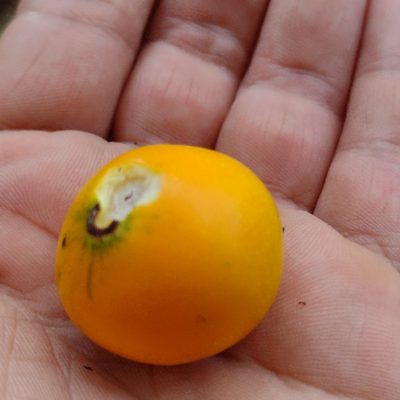This plant was sold to me as Amorphophallus bulbifer. The leaves grow bulbils from the leaf axis, just like A. bulbifer does, but when it finally bloomed I realized that it was definitely not A. bulbifer. I didn’t know what it was though. After some digging around, I was able to ID it. I was actually glad that I had been sold a different species, since Amorphophallus muelleri is much rarer than Amorphophallus bulbifer.
This plant is apomictic, which means that it is capable of producing viable seeds without being pollinated.
The seeds produced via apomixis are clones of the mother plant. When they bloom, leave the inflorescence alone and it may begin to grow fruit and seeds from the side of it. I harvest those seeds in the following spring, and plant them immediately. Like other aroids, the flowers are not capable of pollinating themselves, so those plants will be clones of the mother plant unless you had two inflorescences blooming one day apart from each other.
It also reproduces asexually via bulbils that grow right in the middle of the top of the leaf. The larger the leaf, the larger the bulbil produced. From a seed or a bulbil to a bloomng sized plant takes about five or six years, but after that, they bloom every two years if given proper care.
Amorphophallus muelleri only grows one leaf per year. It does not form offshoots from the tuber, so it is very important to make sure that the leaf is not damaged while it is growing. Do not transplant it while it is growing. The tuber should be planted in the pot it will be staying in for the whole growing season. In Fall, the leaf will fall over, and turn yellow. That is when you should harvest the bulbil from the top of the leaf. After that, you can dig up the tuber and store it in a paper bag until the following Spring. If you live in a mild enough climate, you can leave the tuber in the soil, but it must remain dry while it is dormant or it will rot.
Origin
Southeast Asia
Family
Araceae
Binomial nomenclature
Amorphophallus muelleri
Common names
None
Description
Amorphophallus muelleri grows one, large, radially symmetrical, compound leaf, up to 4′ tall, and 3′ in diameter. They superficially resemble a small palm tree. The petiole of the leaf is mottled with an attractive pattern of light green splotches. The surface of the petiole is smooth. The inflorescence which emerges in the Spring, once every two to five years, is medium sized. The purple spathe is 7″-8″ in diameter, and has white polka dots. The spadix is pointed,and white. The leaf is grown using carbohydrates stored in the tuber. The tuber is completely used up in this process. During the growing season, a new tuber begins to form below the plant, storing resources obtained by the leaf and roots for use in growing the leaf or inflorescence in the following Spring. This species grows only one leaf per year, and does not divide from the tuber.
Height
4′ tall.
Temperature/Zone
zone 9b, 32°F. This plant prefers humid conditions. It goes dormant in Winter. The tubers can be dug up and Wintered in a paper bag, anywhere in the USA.
Light
Part sun to shade.
Water
Keep them evenly hydrated while they are growing, but allow them to dry out completely while they are dormant. If they are too wet while they are dormant they can rot.
Fertilizer
It is important to supply them with phosphorus. Phosphorus is what allows them to grow a larger tuber. Since they grow a new tuber each year, this is largely what determines the size of the plant in the following year. Just as I do for gingers, I use a 1/4 strength liquid fertilizer, formulated for tomatoes on these.
Cultivation
Plant the tuber in very rich, well draining soil. Give them a good amount of root space. Plant it in the pot it will be in for the whole season. You should not transplant them while they are growing. I’ve done it, but it is best not to disturb their roots once they are growing. If the leaf petiole is broken or badly damaged during transplantation it will often cause them to die. It is for this reason that I don’t ship them while they are growing. This species can’t grow multiple leaves in a year though, so don’t allow the leaf to be damaged. It can very likely result in the death of the plant.
Pests
I have not found any pests to be a problem for this plant in Florida.








Hi Dear, are you genuinely visiting this site daily,
if so afterward you will absolutely obtain pleasant know-how.